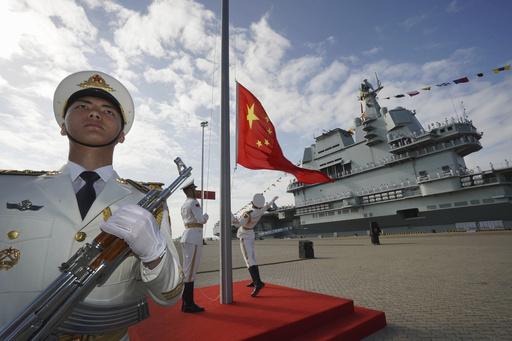
BANGKOK — A land-based prototype for a nuclear reactor intended for a major surface warship has been developed by China, signaling significant progress toward the country’s first nuclear-powered aircraft carrier. This assertion is based on a recent analysis of satellite images and Chinese governmental documentation.
The Chinese navy, already the largest in terms of numbers, is undergoing rapid modernization. The incorporation of nuclear-powered carriers into its fleet would mark a substantial advancement in achieving a “blue-water” naval force capable of operations far from China, presenting an increasing challenge to the United States’ dominance. Tong Zhao, a senior fellow at the Carnegie Endowment for International Peace in Washington, D.C., noted that nuclear carriers would elevate China into the ranks of premier naval powers, alongside the United States and France, and act as a symbol of national prestige.
While initially investigating an area near Leshan in Sichuan province believed to be constructing a reactor for weapons-related plutonium or tritium production, researchers at the Middlebury Institute of International Studies instead discovered evidence supporting the construction of a nuclear prototype intended for naval use. This endeavor is known as the Longwei, or “Dragon Might” Project, officially referred to as the Nuclear Power Development Project in related documents.
Efforts to gain insight from China’s Defense and Foreign Affairs Ministries were met with silence. However, the analysis of satellite imagery and public records provided substantial leads on the carrier project. Researchers confirmed long-held suspicions — that China is indeed working towards a nuclear-powered aircraft carrier propulsion system, marking the first conclusive evidence of such a development.
Jeffrey Lewis, a Middlebury professor involved in this study, stated that this prototype reactor is pivotal because it confirms China’s intent on entering the exclusive group of nations that operate nuclear-powered aircraft carriers. The reactor is reportedly being constructed at a facility known as Base 909, which also contains multiple other reactor projects, further reinforcing this conclusion.
Public procurement documentation, along with environmental reports, indicated that reactor equipment had been acquired for installation on a sizable warship under the Nuclear Power Development Project. This lends credence to the notion that the significant reactor in question is indeed a prototype for a future aircraft carrier. Supporting imagery from 2020 to 2023 revealed significant construction, including the removal of homes nearby, coupled with the addition of infrastructure directly related to the reactor.
An environmental impact report classifies the Longwei Project as “national defense-related” and marked as “secret.” Researchers firmly concluded that unless China is pursuing nuclear-powered cruisers — a pursuit only seen previously in the U.S. and Soviet naval histories — this project likely concerns developing a nuclear-powered aircraft carrier.
Jamie Withorne, an analyst at the Oslo Nuclear Project who reviewed the research, remarked on the solid arguments put forth by the Middlebury team about the reactor’s potential use. She noted that co-location with existing naval reactor facilities and construction activities provided compelling evidence that further solidifies their assessments. However, the timeline for when such a nuclear-powered carrier might be operational remains unclear.
China’s first aircraft carrier was a modified Soviet vessel commissioned in 2012, followed by its second, built domestically but based on a Soviet design. Both, known as the Liaoning and the Shandong, utilize a ski-jump system for launching aircraft. The Type 003 Fujian, launched in 2022, is China’s third carrier, custom-designed with an advanced electromagnetic launch system similar to that of the U.S. Navy, although all three carriers currently rely on conventional power.
Even before sea trials had begun for the Fujian, military officials had indicated plans for a fourth carrier, leaving the question of whether it would be nuclear-powered open yet to be confirmed. Speculation exists around the possibility of producing two carriers simultaneously — one nuclear and one conventional — leveraging existing shipyard capabilities.
Experts remain divided on whether the next carrier will implement nuclear power. Some believe that the focus will instead be on refining existing designs with incremental enhancements. Nick Childs from the International Institute for Strategic Studies suggested that while on-deck operations have remained cautious and close to mainland shores, future advancements in carrier design would ultimately provide more options for power projection.
The potential transition to nuclear-powered carriers would significantly expand China’s operational capabilities. Nuclear power not only circumvents the need for regular refueling — substantially increasing the vessel’s range — but frees up space on-board for additional fuel and munitions needed by carrier-based aircraft.
Zhao mentioned that nuclear carriers would grant China enhanced flexibility, potentially allowing operations in contested areas like the First Island Chain, which includes Taiwan. This location is vital to China’s maritime strategy, where tensions frequently arise between regional nations and the U.S., which supports Taiwan’s defense capabilities.
President Xi Jinping has emphasized the need for a first-class navy as part of China’s broader rejuvenation goals. Recent defense white papers indicate an increased mission scope for the navy, evolving from regional defense to far-seas protection. Currently, China’s navy comprises more than 370 vessels, marked by superior shipbuilding capabilities compared to the U.S.
Despite the rapid expansion of its fleet, the Chinese navy still lags behind in several aspects compared to the U.S. Navy, particularly regarding the operational capabilities of nuclear-powered carriers. The Pentagon has expressed growing concerns over the modernization of China’s naval fleet, identifying a pressing need for the U.S. to adapt to these advancements within a fluid maritime environment.
In summary, the development of a nuclear-powered aircraft carrier represents a critical step in China’s ongoing naval ambitions and strategic positioning within the growing U.S.-China rivalry. This evolution could serve to enhance China’s ability to project its military influence beyond its immediate coastal waters, thus reshaping regional power dynamics.
